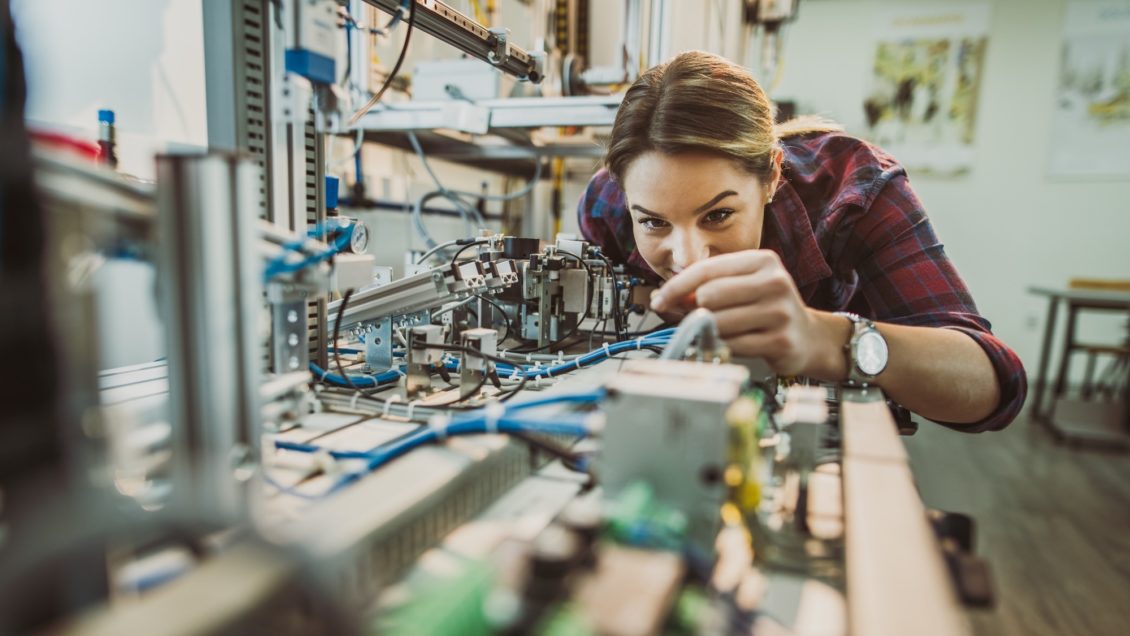Advanced materials are big business in South Carolina. It’s a new story. But it should have a familiar ring to it, one that dates back more than a century, when the textile industry built our cities, brought new jobs and powered an emerging, modern economy.
What textiles were to the 20th century, advanced materials are today. These integral yet still-developing parts of our everyday, 21st-century lives are attracting new jobs and new investments across the Palmetto State. And like textiles, advanced materials are hard at work all around us, from our hospitals and homes and to our workplaces and more, making medicine more effective, machines more efficient and our world more sustainable.
The future of economic development in the area of advanced materials relies on three key things: recruiting top talent, providing relevant and cutting-edge programming, and having world-class facilities in place that support those people and programs.
Anand Gramopadhye, dean of the College of Engineering, Computing and Applied Sciences.
Advanced plastics. Optics. Photonics. Composite materials. With these advanced materials and more, South Carolina is making sure the world’s manufacturers are supplied with what they need to make some of industry’s most complex products. To keep pace, Clemson University is prioritizing its research dollars in this innovation cluster of advanced materials, allocating $14.3 million in research expenditures in fiscal year 2021.
With additional funding, which Clemson continues to pursue through public and private partnerships, the University is working to ensure a bright future — not only for South Carolinians but for the world, Gramopadhye says.
“The AMIC facility will be a home for Clemson’s materials science and engineering department along with synergistic programs from the chemical and biomolecular engineering and chemistry departments,” he says.
And enlisting the support of stakeholders and partners in government and industry as this unique building comes online should be fortuitous for the University and the state.
Says Cynthia Young, founding dean of Clemson’s College of Science: “Advanced materials are driving advancements in diverse technology fields including electrified transportation, medical imaging, personal cosmetics, energy harvesting from wind and solar, and many others.”
Corridor of growth
The Piedmont-Atlantic region that includes Upstate South Carolina was once home to some of the most productive textile mills in the country. Now, the area that spans from Atlanta to Charlotte is home to an emerging but prolific advanced materials economy. In addition to being one of the fastest-growing regions in the country, this part of the Southeast has one of the highest number of engineers per capita in the U.S., according to Upstate S.C. Alliance, an industry support and recruitment organization.
Thanks to that growth, the state’s robust STEM economy is ideally positioned to serve as a hub for advanced materials. Over the last decade, advanced materials as an industry has grown by more than 10,000 jobs and seen $4.5 billion in capital investment, according to the state commerce department.
One of the ways Clemson is looking to the future is with its Advanced Materials Innovation Complex (AMIC), a proposed facility recently approved by Clemson’s board of trustees that will serve as a home base for research, discovery and scientific advancement. Upon completion, it will represent the University’s most technologically advanced facility, further cementing Clemson’s Carnegie designation as an R1 research institution.
The facility will be located on Clemson’s main campus, and it will include cutting-edge research and innovative teaching laboratories, dynamic classrooms and shared collaborative spaces for academia and industry.
As we tackle some of tomorrow’s grand challenges and prepare the next generation of scientists and engineers, the AMIC will provide Clemson students, faculty and industry partners with a state-of-the-art facility to support the integrated discovery, innovation and learning that are the hallmarks of a Clemson education.
Cynthia Young, founding dean of Clemson’s College of Science
Investing in education
South Carolina’s 21st-century economy will be powered by the technologies and talent tied to advanced materials. But those ideas and inventions will get their start at Clemson.
More than 250 researchers, educators and support personnel from the departments of Materials Science and Engineering, Chemistry, and Chemical and Biomolecular Engineering will be among those working collaboratively in the new AMIC space, serving as a sizable recruiting tool for future talent and innovation. Undergraduate labs will accommodate more than 12,000 students weekly from the heart of main campus, and the building’s proposed footprint of 143,000 square feet represents a visible, sizable step in expanding efforts to support advanced materials research. The facility represents a statewide partnership with the Battelle Savannah River Alliance in connection with the Savannah River National Laboratory.
George J. Bishop, III Endowed Chair in Ceramic and Materials Engineering Rajendra Bordia and his research group are focusing on the processing and mechanics of ceramic coatings for extreme environment and porous ceramics for energy conversion and storage. Bordia’s role as director for MADE in SC, a program that is funded with $20 million from the National Science Foundation’s Established Program to Stimulate Competitive Research, brings together 69 participants from 10 of the state’s higher-education institutions. The program’s three thrusts are optical, electrochemical and magnetic materials; stimuli-responsive polymeric materials; and interactive biomaterials.
Associate professor Rachel Getman’s emphasis area is on energy, and her current research focuses on understanding the gas and aqueous phase catalysis. Catalysts accelerate the rate of chemical reactions and are crucial to mass-producing a vast range of products from gasoline and diesel fuel to fertilizer and plastic. She is interested in developing catalysts for biomass reforming, water purification, exhaust gas treatment and other environmental and sustainability efforts. Her lab includes two postdoctoral researchers, five Ph.D. scholars, a master’s student and an honors undergraduate student.
Professor and Associate Dean of Science Stephen Creager studies electrochemical science with an emphasis on electrical energy conversion and storage. This work includes hydrogen fuel cells, water electrolysis cells and lithium-ion battery materials, an energy emphasis that has implications for advanced manufacturing in South Carolina and beyond.
“Together, we are preparing to make a transformative impact,” says Gramopadhye. “One that will bring us lasting success and prosperity for our institution and our state through innovation and preparation of the next generation of work force, in support of advanced manufacturing, energy and health innovation.”
Developing new talent
In high school, Sarah Sandler thought that she wanted to be a marine biologist. It wasn’t until she began the college visitation process that she realized she liked science as a whole. Clemson’s engineering program was particularly attractive to the Merrick, New York, native because first-year students explore all forms of engineering before landing on a specific one as a major. For Sarah, a year as a general engineering student meant discovering the freedom to explore which avenues would be the best fit for her future.
Starting her first year, she began working with undergraduate research projects that interested her — a journey that led her to meet Thompson Mefford, the David and Mary Ann Bishop Dean’s Associate Professor of Materials Science and Engineering. The Mefford group studies nanoparticle synthesis and the development of surface modification with functional polymers. She joined his Creative Inquiry course, investigating ferrite nanoparticles, a field of health research technology that shows promise for fighting bacteria and shrinking tumors.
The work did more than inspire her. It helped her identify her academic passion: “I ended up deciding to major in materials science and engineering because of that project.”
Mefford’s project required Sandler to understand chemical synthesis, nanomaterial characterization and special measurement techniques, such as AC calorimetry and susceptibility, describing the young student as “a natural in the research environment.”
“If I hadn’t come to Clemson, I wouldn’t have discovered my passion for research,” Sandler says.
Clemson cultivated Sandler’s passion for research and prepared her for a postgraduate career to continue to develop her research in nanoparticles specifically — she is now a Ph.D. student at the University of Cambridge’s Cavendish Laboratory. In addition to her studies, she serves as chairperson of the Cambridge University Nanotechnology Society.
Advanced Materials by the Numbers
10,300
New jobs announced by advanced materials firms from 2011-2020.*
$4.5B
Capital investment announced by advanced materials firms from 2011-2020.*
800
Advanced materials and composites firms in South Carolina.*
*Source: South Carolina Department of Commerce


